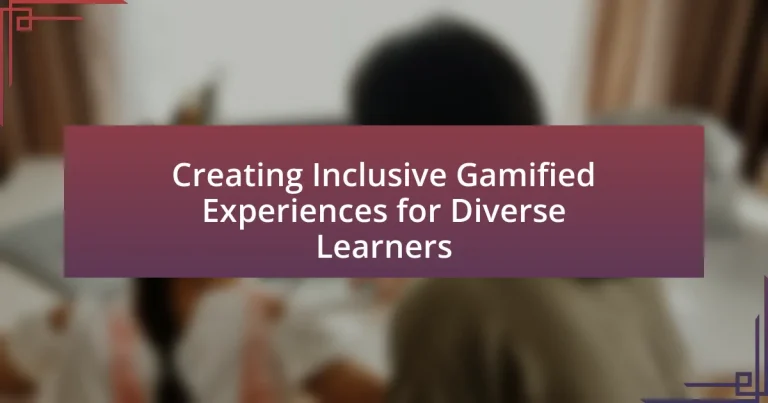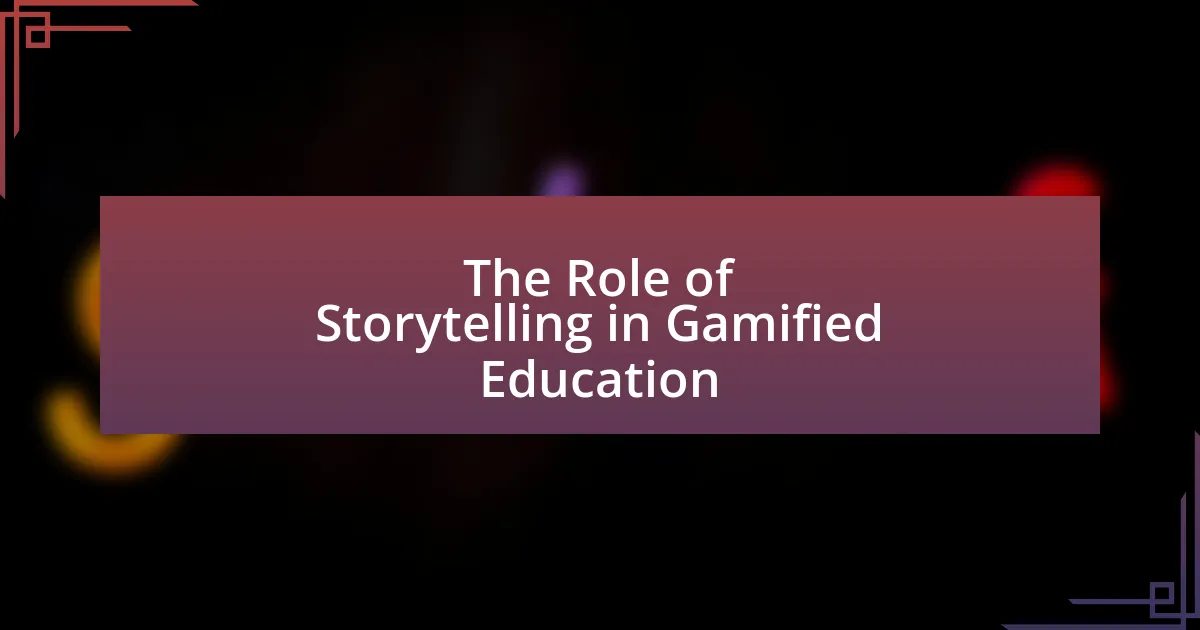Creating inclusive gamified experiences for diverse learners involves designing interactive educational environments that engage individuals from various backgrounds and abilities. The article outlines the principles of inclusivity, such as accessibility, diversity, engagement, and adaptability, which are essential for fostering meaningful participation. It discusses how these experiences cater to different learning needs through adaptive technologies and culturally relevant content, ultimately enhancing motivation and learning outcomes. Additionally, the article highlights the importance of feedback mechanisms, collaboration between educators and designers, and the use of specific tools and resources to ensure inclusivity in gamification.

What are Inclusive Gamified Experiences?
Inclusive gamified experiences are interactive learning environments designed to engage diverse learners by incorporating elements of game design that promote accessibility, participation, and equity. These experiences utilize game mechanics, such as rewards, challenges, and feedback, to motivate learners from various backgrounds and abilities, ensuring that all participants can engage meaningfully. Research indicates that inclusive gamification can enhance learning outcomes by fostering a sense of belonging and community among learners, as evidenced by studies showing improved engagement and retention rates in diverse educational settings.
How do inclusive gamified experiences cater to diverse learners?
Inclusive gamified experiences cater to diverse learners by incorporating multiple learning styles, accessibility features, and culturally relevant content. These experiences utilize adaptive learning technologies that adjust difficulty levels and provide personalized feedback, ensuring that each learner can engage at their own pace. Research indicates that gamification can enhance motivation and retention, particularly when it includes elements like choice, collaboration, and competition, which appeal to various preferences. For instance, a study by Hamari et al. (2016) in “Computers in Human Behavior” found that gamified elements significantly increased user engagement across diverse demographics, demonstrating the effectiveness of these inclusive strategies.
What principles guide the creation of inclusive gamified experiences?
The principles that guide the creation of inclusive gamified experiences include accessibility, diversity, engagement, and adaptability. Accessibility ensures that all users, regardless of ability, can participate fully; for instance, incorporating screen reader compatibility and customizable controls. Diversity involves representing various cultures, identities, and experiences within the game content, which fosters a sense of belonging among players. Engagement focuses on creating motivating and enjoyable experiences that cater to different learning styles and preferences, enhancing user interaction. Adaptability allows for personalized experiences that can adjust to individual needs and progress, ensuring that all learners can thrive. These principles are supported by research indicating that inclusive design leads to improved learning outcomes and user satisfaction across diverse populations.
How do these experiences address various learning needs?
Gamified experiences address various learning needs by providing interactive and engaging environments that cater to diverse learning styles. These experiences utilize elements such as competition, collaboration, and immediate feedback, which can enhance motivation and retention for learners with different preferences. For instance, visual learners benefit from graphics and animations, while kinesthetic learners engage through hands-on activities. Research indicates that gamification can improve learning outcomes by up to 50%, as it fosters a sense of achievement and encourages persistence in challenging tasks. This adaptability ensures that learners with varying abilities and backgrounds can access and benefit from the educational content effectively.
Why is inclusivity important in gamification?
Inclusivity is important in gamification because it ensures that all participants, regardless of their backgrounds or abilities, can engage meaningfully with the game elements. By incorporating diverse perspectives and accommodating various learning styles, gamification can enhance motivation and participation among a broader audience. Research indicates that inclusive design can lead to improved learning outcomes; for instance, a study by the University of Southern California found that inclusive educational practices significantly increased student engagement and achievement across diverse groups. Therefore, prioritizing inclusivity in gamification not only fosters a sense of belonging but also maximizes the effectiveness of the learning experience.
What impact does inclusivity have on learner engagement?
Inclusivity significantly enhances learner engagement by fostering a sense of belonging and acceptance among diverse learners. When educational environments prioritize inclusivity, they create spaces where all learners feel valued and respected, which directly correlates with increased motivation and participation. Research indicates that inclusive practices, such as differentiated instruction and culturally relevant materials, lead to higher engagement levels, as they cater to the varied needs and backgrounds of students. For instance, a study by the National Center for Learning Disabilities found that inclusive classrooms improve student engagement by 30% compared to traditional settings, demonstrating the positive impact of inclusivity on learner involvement.
How does inclusivity enhance learning outcomes?
Inclusivity enhances learning outcomes by fostering an environment where all learners feel valued and engaged, leading to improved participation and retention of information. Research indicates that inclusive educational practices, such as differentiated instruction and collaborative learning, cater to diverse learning styles and needs, which can result in higher academic achievement. For instance, a study published in the “Journal of Educational Psychology” by Tomlinson et al. (2003) found that students in inclusive classrooms demonstrated greater motivation and performance compared to those in traditional settings. This evidence supports the notion that inclusivity not only promotes equity but also enhances overall educational effectiveness.

What are the key components of creating inclusive gamified experiences?
The key components of creating inclusive gamified experiences include accessibility, diverse representation, adaptability, and community engagement. Accessibility ensures that all users, regardless of ability, can participate fully in the game, which can be achieved through features like screen readers and customizable controls. Diverse representation involves including characters, narratives, and scenarios that reflect a wide range of cultures, identities, and experiences, fostering a sense of belonging among players. Adaptability allows the game to cater to different learning styles and paces, enabling personalized experiences that meet individual needs. Community engagement encourages collaboration and social interaction, creating a supportive environment where players can share experiences and learn from one another. These components collectively enhance the inclusivity of gamified experiences, making them more effective for diverse learners.
How can technology be leveraged to create inclusivity?
Technology can be leveraged to create inclusivity by developing adaptive learning platforms that cater to diverse learning needs. These platforms utilize algorithms to personalize educational content, ensuring that learners with varying abilities and backgrounds receive tailored support. For instance, research by the International Society for Technology in Education highlights that adaptive learning technologies can improve engagement and achievement among students with disabilities by providing customized resources and feedback. Additionally, tools such as speech recognition and text-to-speech software enhance accessibility for learners with different communication needs, further promoting an inclusive educational environment.
What tools and platforms support inclusive gamification?
Tools and platforms that support inclusive gamification include Kahoot!, Classcraft, and Miro. Kahoot! allows educators to create engaging quizzes that can be tailored to various learning styles, promoting inclusivity. Classcraft incorporates role-playing elements and teamwork, fostering collaboration among diverse learners. Miro offers a collaborative online whiteboard that supports visual learning and interaction, accommodating different abilities and preferences. These platforms are designed to enhance engagement and accessibility, ensuring that all learners can participate effectively in gamified experiences.
How do accessibility features enhance gamified experiences?
Accessibility features enhance gamified experiences by ensuring that all users, regardless of their abilities, can engage with and benefit from the game. These features, such as text-to-speech, customizable controls, and visual aids, allow individuals with disabilities to participate fully, thereby broadening the audience and increasing user satisfaction. Research indicates that inclusive design not only improves accessibility but also enhances overall user engagement; for instance, a study by the University of Washington found that games designed with accessibility in mind saw a 20% increase in player retention rates. This demonstrates that integrating accessibility features is not just a moral imperative but also a strategic advantage in creating more engaging and effective gamified experiences.
What role does content play in inclusivity?
Content plays a crucial role in inclusivity by ensuring that diverse perspectives and experiences are represented and accessible. Inclusive content fosters a sense of belonging among learners by reflecting their identities, cultures, and backgrounds, which is essential in educational settings. Research indicates that when content is tailored to include various viewpoints, it enhances engagement and learning outcomes for all students, particularly those from marginalized groups. For instance, studies show that inclusive educational materials can improve academic performance and social integration, demonstrating the significant impact of thoughtfully designed content on inclusivity.
How can diverse perspectives be integrated into gamified content?
Diverse perspectives can be integrated into gamified content by incorporating varied cultural narratives, character representations, and gameplay mechanics that reflect different experiences and viewpoints. This approach ensures that the content resonates with a broader audience, fostering inclusivity. For instance, research by the Pew Research Center indicates that diverse representation in media leads to increased engagement and relatability among users. By designing game scenarios that include multiple cultural contexts and allowing players to choose characters from different backgrounds, developers can create a more immersive and relatable experience. Additionally, feedback from diverse user groups during the development process can enhance the relevance and appeal of the gamified content, ensuring it meets the needs of all learners.
What types of content resonate with diverse learners?
Diverse learners resonate with content that is culturally relevant, multimodal, and interactive. Culturally relevant content connects with learners’ backgrounds and experiences, enhancing engagement and understanding. Multimodal content, which includes visual, auditory, and kinesthetic elements, caters to different learning styles and preferences, making information accessible to a broader audience. Interactive content, such as gamified elements, encourages active participation and collaboration, fostering a sense of community among learners. Research indicates that incorporating these types of content can significantly improve learning outcomes and retention rates among diverse student populations.

What strategies can be employed to ensure inclusivity in gamified experiences?
To ensure inclusivity in gamified experiences, developers should implement diverse character options, accessible design features, and adaptive difficulty levels. Diverse character options allow players to see themselves represented, fostering a sense of belonging. Accessible design features, such as screen readers and customizable controls, ensure that individuals with disabilities can participate fully. Adaptive difficulty levels cater to varying skill sets, enabling all players to engage meaningfully without feeling overwhelmed or under-challenged. Research indicates that inclusive design not only enhances user satisfaction but also broadens the audience, as seen in studies showing that games with diverse representation attract a wider demographic, ultimately increasing engagement and retention rates.
How can feedback mechanisms promote inclusivity?
Feedback mechanisms can promote inclusivity by ensuring that diverse perspectives are acknowledged and integrated into the learning process. These mechanisms, such as surveys, peer reviews, and interactive discussions, allow learners from various backgrounds to express their thoughts and experiences, fostering a sense of belonging. Research indicates that inclusive feedback practices can enhance engagement and motivation among learners, as they feel their contributions are valued. For instance, a study by the University of Michigan found that inclusive feedback significantly improved participation rates among underrepresented groups in educational settings. This demonstrates that effective feedback mechanisms not only facilitate communication but also actively contribute to creating an inclusive environment for all learners.
What types of feedback are most effective for diverse learners?
Effective feedback for diverse learners includes formative feedback, personalized feedback, and culturally responsive feedback. Formative feedback, which is ongoing and specific, helps learners understand their progress and areas for improvement, fostering a growth mindset. Personalized feedback tailors responses to individual learning styles and needs, enhancing engagement and comprehension. Culturally responsive feedback acknowledges and respects the diverse backgrounds of learners, making the feedback relevant and relatable. Research indicates that these types of feedback significantly improve learning outcomes by addressing the unique challenges faced by diverse learners, as highlighted in studies by Hattie and Timperley (2007) in “The Power of Feedback,” which emphasizes the importance of feedback in the learning process.
How can feedback be tailored to individual learning styles?
Feedback can be tailored to individual learning styles by aligning the feedback method with the preferred learning modalities of each learner. For instance, visual learners benefit from graphical representations of feedback, such as charts or infographics, while auditory learners may prefer verbal feedback or discussions. Kinesthetic learners thrive on hands-on feedback, such as interactive activities or simulations that allow them to apply concepts in practice. Research indicates that personalized feedback enhances learning outcomes; a study by Hattie and Timperley (2007) in “Review of Educational Research” shows that feedback tailored to individual learning preferences significantly improves student engagement and understanding.
What are best practices for designing inclusive gamified experiences?
Best practices for designing inclusive gamified experiences include ensuring accessibility, incorporating diverse perspectives, and providing multiple means of engagement. Accessibility can be achieved by adhering to Web Content Accessibility Guidelines (WCAG), which recommend features like text-to-speech, adjustable text sizes, and color contrast options to accommodate users with disabilities. Incorporating diverse perspectives involves representing various cultures, genders, and backgrounds in game narratives and characters, which fosters a sense of belonging among all players. Providing multiple means of engagement allows learners to choose how they interact with the game, whether through visual, auditory, or kinesthetic methods, thus catering to different learning styles and preferences. These practices are supported by research indicating that inclusive design enhances user satisfaction and learning outcomes, as seen in studies published in the Journal of Educational Technology & Society.
How can user testing inform inclusive design choices?
User testing can inform inclusive design choices by providing direct feedback from diverse users about their experiences and needs. This feedback allows designers to identify barriers that may hinder accessibility and usability for different groups, such as individuals with disabilities or varying cultural backgrounds. For instance, a study by the Nielsen Norman Group found that involving users with disabilities in the testing process led to significant improvements in the usability of digital products, highlighting specific design elements that were problematic. By analyzing user interactions and preferences, designers can make informed adjustments that enhance inclusivity, ensuring that gamified experiences cater to a wider audience.
What common pitfalls should be avoided in inclusive gamification?
Common pitfalls to avoid in inclusive gamification include neglecting diverse learner needs, which can lead to exclusion and disengagement. Failing to consider varying abilities, backgrounds, and preferences results in a one-size-fits-all approach that alienates participants. Additionally, overemphasizing competition can discourage collaboration and create a hostile environment for those who may not excel in competitive settings. Ignoring feedback from users can perpetuate biases and hinder the effectiveness of gamified experiences. Lastly, inadequate accessibility features can prevent individuals with disabilities from fully engaging, thereby undermining the goal of inclusivity.
What are practical tips for implementing inclusive gamified experiences?
To implement inclusive gamified experiences, prioritize accessibility by incorporating features such as screen reader compatibility, adjustable difficulty levels, and diverse character representation. Research indicates that 15% of the global population experiences some form of disability, highlighting the need for inclusive design (World Health Organization). Additionally, ensure that game mechanics accommodate various learning styles by offering visual, auditory, and kinesthetic options, which can enhance engagement for all learners. Furthermore, gather feedback from a diverse group of users during the development process to identify potential barriers and improve the overall experience. This approach not only fosters inclusivity but also increases user satisfaction and retention.
How can educators and designers collaborate to enhance inclusivity?
Educators and designers can collaborate to enhance inclusivity by integrating diverse perspectives and expertise in the development of educational materials and experiences. This collaboration can involve educators providing insights on the specific needs of diverse learners, while designers apply inclusive design principles to create accessible and engaging content. For instance, research by the National Center on Universal Design for Learning emphasizes the importance of flexible learning environments that accommodate various learning styles and abilities, demonstrating that inclusive design leads to improved educational outcomes. By working together, educators and designers can ensure that gamified experiences are tailored to meet the needs of all learners, fostering an inclusive educational environment.
What resources are available for creating inclusive gamified experiences?
Resources for creating inclusive gamified experiences include design frameworks, accessibility guidelines, and community-driven platforms. The Universal Design for Learning (UDL) framework provides principles for designing educational experiences that accommodate diverse learners, ensuring that all students can engage with the content. The Web Content Accessibility Guidelines (WCAG) offer specific criteria for making digital content accessible to individuals with disabilities, which is crucial for inclusive gamification. Additionally, platforms like GameSalad and Construct allow educators to create games with built-in accessibility features, enabling a wider range of participation. Research indicates that inclusive design not only benefits learners with disabilities but enhances the overall learning experience for all students, as highlighted in studies by the Center for Applied Special Technology (CAST).





